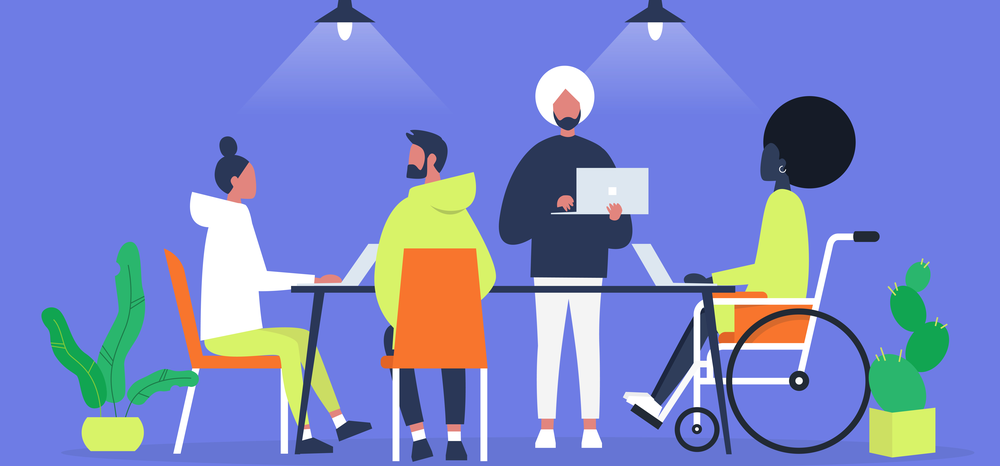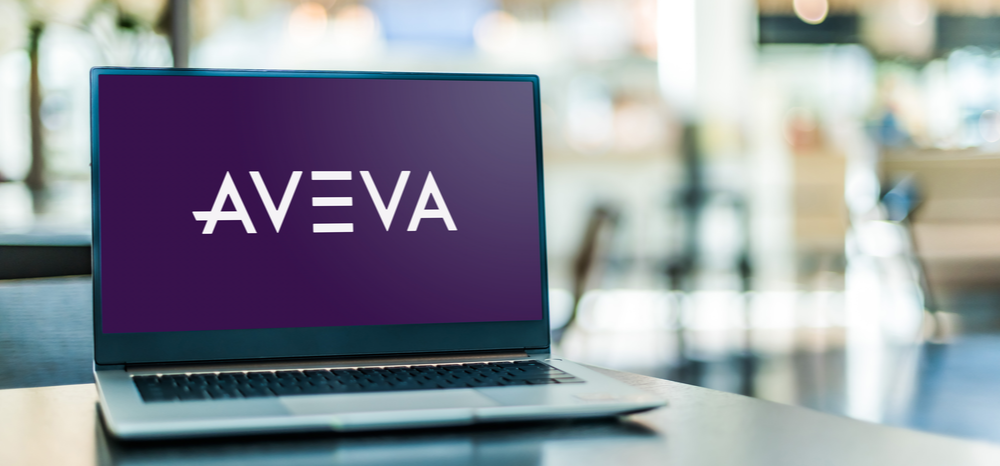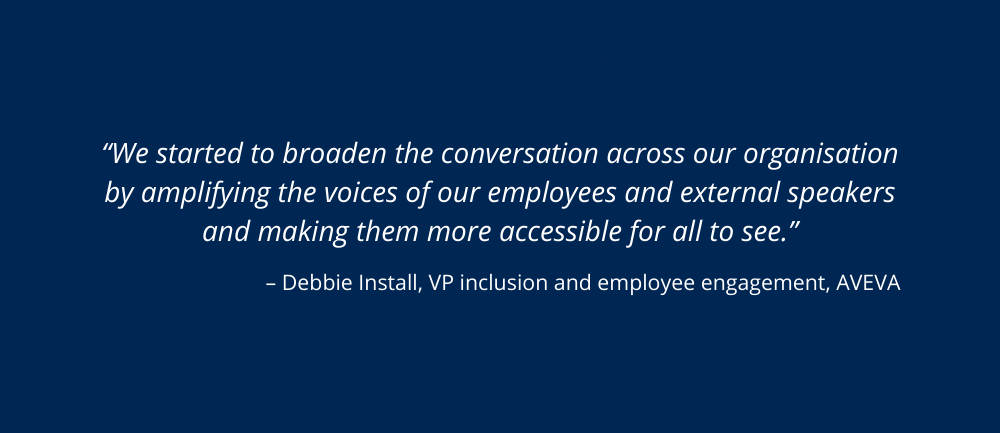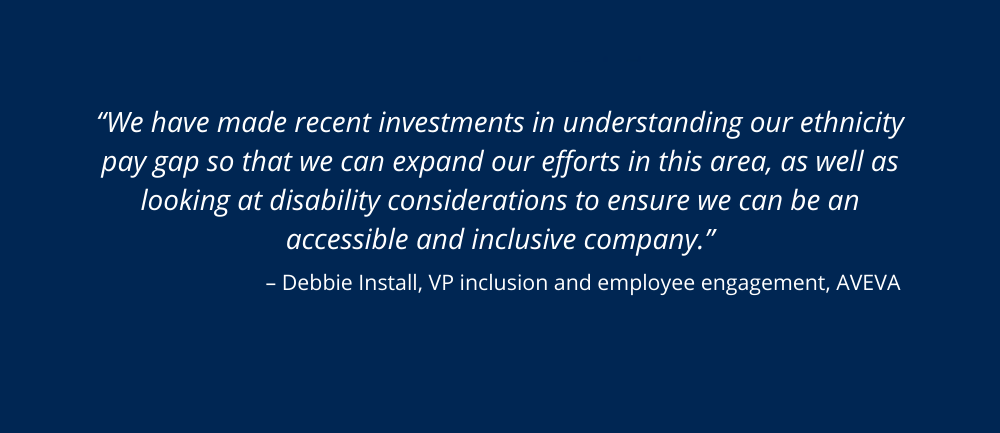-
Provided by

- Date published: Jul 19, 2021
- Categories
Over the past year, DEI has been a top priority for the leading engineering and industrial software brand AVEVA. This includes establishing a DEI strategy, implementing governance, creating a DEI policy, gaining commitment on this topic from the executive team, rolling out training, and accelerating the previous targets.
During that time, AVEVA saw two challenges arise simultaneously. The first was the imperative to broaden the conversation around DE&I, which had a long-running focus on gender; secondly, COVID brought into the spotlight the need to have employee wellbeing initiatives in place.
In this case study, Debbie Install, AVEVA’s VP inclusion and employee engagement, shares how the brand has successfully implemented its strategy to overcome the challenges it recognised.
The challenge
George Floyd’s murder placed a very important spotlight on the topic of race, discrimination and how we as an organisation would ensure we had a truly global culture of inclusivity. Additionally, we faced a global challenge due to the pandemic – our employees needed support. As an organisation, we wanted to respond in a way that rang true with our employees, and given the focus on gender, this was not the case, so we knew we had to quickly do more.
Wellbeing within AVEVA was patchy; not all countries had access to services, and only some managers were comfortable talking about wellbeing issues. A feeling that we were paying lip service to important issues, we did not understand our workforce demographics and the challenges faced, and we lacked an infrastructure to give our employees a voice.
When the pandemic started, overnight we asked our whole workforce to work remotely, and so employees had both personal and work challenges to contend with which we needed to provide practical support for. We were also acutely aware of the effect significant change has upon an individual as well as on a company. It was essential that we provided the tools needed to navigate this new world.

Devising a solution
The DE&I resource at the time was one part-time lead. It was very clear that not enough resource and support was being given. We decided to move the responsibility to sit with the employee communications team and then set up a Tiger Team.
This was a priority for the organisation, so we needed to provide an immediate increase in headcount to support it. This new team comprises the DE&I lead, and members from various teams including talent, talent development, reward and communications. These colleagues were on an initial secondment for six months and together we set our priorities.
We had four weeks to do a review of our current wellbeing and DE&I strategies, research best practice and develop a proposal for leadership to implement. We built our initial proposal outlining our gaps and what were the foundations we needed to put in place – the areas we could build upon with speed and the areas that needed investment and support.

Adopting the right tools
We utilised some of the tools we had available, including our social intranet. We started to broaden the conversation across our organisation by amplifying the voices of our employees and external speakers and making them more accessible for all to see. We covered a range of topics from race and sexual orientation to mental health, and we provided tool kits for managers.
We used the CEO Podcast channel and all employee calls to talk about DE&I across the organisation. We also used our regular managers’ briefings and employee all hands calls, which included members of the executive leadership team, and helped connect senior leaders with employees, provide reassurance, guidance, direction and support.
An area that we identified as an issue was lack of employee data. To better understand our organisation we added demographic details to our employee survey tool along with specific DE&IW questions.
We identified five focus areas for building the foundations:
- Improved analytics and compliance
- Talent management
- Broadening the conversation
- Fostering a culture of inclusivity
- Governance
Securing C-suite support
Part of our governance model was to ensure that the board and executive team were aware of what the current situation looked like. Therefore, we shared analytics, best practice and highlighted our gaps and how we proposed to make changes.
As part of our regular cadence of meetings the CEO received a detailed update each month on progress and attended sessions with employees. The CEO and the exec team were sponsors of each of the areas of focus and released resources where specific skills were needed such as legal or analytical expertise.
As a result of this regular cadence and buy in from the exec, we secured budget for both DE&IW activities and our first global DE&I director. We increased our headcount for DE&IW dramatically which reflected the importance placed on the topic within AVEVA.

Our CTO is the sponsor for the @Women network which initially started in the R&D function and is now across the whole organisation, with the CTO championing the activities.
We also ran a workshop with our strategic leadership team, the next layer of leaders within the organisation who could influence. They received the same updates as ELT and we also invited along a guest speaker to talk about bias to challenge the thinking of our leaders. This workshop helped shape the content for our mandatory training.
We provided talking points and topics for our leaders to share internally.
Additionally, our Chief Sustainability Officer has championed the inclusion of DE&I as part of our ESG strategy. We fall under the ‘S’: social issues, a company’s relationships within society including diversity, equity, and inclusion, labour relations and human rights in the workforce, value chain, and broader communities.
This gives us additional visibility and governance at exec and board level – enabling us to leverage support where needed.

Outcomes to date
From a wellbeing perspective we rolled an employee assistance programme out across all regions, and provided toolkits and resources for managers to support their teams. We now have a global wellbeing network that discusses specific issues and puts plans in place to support them. We provided all employees with an allowance to make working from home more comfortable and we brought in external speakers to cover a range of topics. Mental health week was a focus for us to provide a campaign of activities and events and bringing a spotlight to the topic.
In terms of belonging and inclusivity, once employees were working remotely, we wanted a way to recognise the hard work of colleagues so we launched a formal platform called MyRecognition. Employee feedback has been very positive.
Additionally, a member of the Tiger Team has now been appointed into the position of our very first Wellbeing Manager and they lead on all activities globally. This came about as a result of highlighting the importance of the topic to the exec and the value this brings to the organisation.
For DE&I, while we are still very much at the beginning of our journey, we are making solid progress formalising and accelerating our DEI program. We have made significant progress across the five key areas. Post the acquisition of OSIsoft, a data management platform for industrial operations, in March 2021, we have already brought the two individual programmes together and developed a JOINT one-year plan as we continue to integrate.
We are focusing our efforts on considerations for gender, ethnicity and culture, religion and belief, disability and sexual orientation.
We are also focusing on supporting our leaders through dedicated DEI coaching and co-mentoring programmes. Additionally, we have made recent investments in understanding our ethnicity pay gap so that we can expand our efforts in this area, as well as looking at disability considerations to ensure we can be an accessible and inclusive company for colleagues with a range of abilities.
Additionally to this we have:
- Developed and rolled out mandatory DE&I training. All employees are required to undertake training to support their understanding of bias and discrimination and what they can do to help create a more inclusive culture.
- Set up a governance model that includes regional DE&I networks and employee groups who regularly meet and talk through challenges, to ensure we continue to capture the voice of our people. We have created a fund for all of these groups, so they have autonomy. Our employee groups are instrumental to this allyship and play a vital role in raising awareness and facilitating dialogue. These networks continue to grow in number and momentum within AVEVA, and we currently have active employee networks for wellbeing, BLACK Voices, pride, recognising former service personnel, and women.
- Developed and published our first global D&I policy and continue to review and enhance our policies.
- Celebrated pride month for the first time in AVEVA – supported by our pride network – both internally and externally.
- Significantly increased awareness across the organisation on DE&I.
Key learnings for the future
We’re focusing on managing expectations around speed and time to implement. Our work has also highlighted that there isn’t a need to jump straight into talking about what was achieved.
There are a number of successes in collaboration. This was a true team effort with multi-team support. You need the expertise from others including reward, analytics, talent, employees and external experts. We saw great development in communication and stakeholder engagement. Achieving this is critical to supporting the conversation across the business and achieving buy in.
We ran an all employee event ‘AVEVAFEST’ with content spanning a range of topics, and DE&I was a prominent one with fantastic interaction from across the globe. The DE&IW do not own the activities but instead facilitate and support them. The business and our employees are the ones who are making the impact.
Finally, the acceleration through the Tiger Team was critical. Having a team dedicated and passionate about facilitating the changes needed was something that cannot be underestimated – they were amazing!

